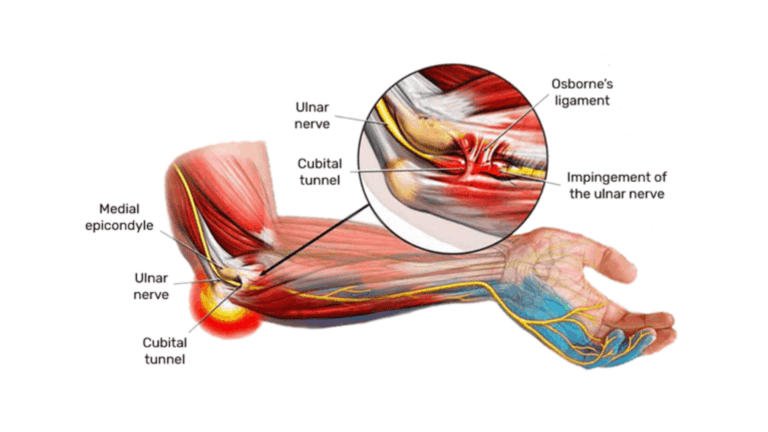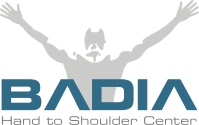

El síndrome del túnel cubital es una afección provocada por un aumento de la presión sobre el nervio cubital a la altura del codo. Hay una protuberancia ósea en la parte interna del codo (epicóndilo medial) por debajo de la cual pasa el nervio cubital. Este lugar suele denominarse "hueso de la risa". En este lugar, el nervio cubital se encuentra directamente junto al hueso y es susceptible a la presión. Cuando la presión sobre el nervio es lo suficientemente grande como para alterar su funcionamiento, puede producirse entumecimiento, hormigueo y dolor en el codo, el antebrazo, la mano y/o los dedos.
El entumecimiento u hormigueo se produce con mayor frecuencia en los dedos anular y meñique. Los síntomas suelen aparecer cuando se ejerce presión sobre el nervio cubital, por ejemplo al sentarse con el codo apoyado en un reposabrazos o al doblar y estirar el codo repetidamente. A menudo, los síntomas se sienten cuando el codo se mantiene doblado durante un periodo de tiempo, como cuando se sujeta el teléfono o mientras se duerme. Algunos pacientes pueden notar debilidad al pellizcar, torpeza ocasional y/o tendencia a dejar caer objetos. En casos graves, puede perderse la sensibilidad y los músculos de la mano pueden perder volumen y fuerza.
El diagnóstico del síndrome del túnel cubital puede realizarse basándose en pruebas clínicas sencillas y en los síntomas del paciente, y se confirma mediante un estudio detallado de conducción nerviosa. Este estudio mide la velocidad y la latencia de los impulsos nerviosos a través del nervio cubital en el codo.
En ocasiones, los síntomas pueden aliviarse sin cirugía, sobre todo si el estudio de conducción nerviosa muestra que la presión sobre el nervio es mínima. Cambiar los patrones de uso del codo puede reducir significativamente la presión sobre el nervio. Evitar poner el codo sobre superficies duras puede ayudar, o llevar una codera sobre el nervio cubital puede ayudar. Mantener el codo recto por la noche con una férula también puede ayudar.
Cuando los síntomas son graves o no mejoran con el tratamiento conservador, puede ser necesaria la cirugía para aliviar la presión sobre el nervio. Muchos cirujanos recomiendan desplazar el nervio hacia la parte delantera del codo, lo que alivia la presión y la tensión sobre el nervio. Algunos cirujanos pueden recomendar recortar la protuberancia ósea de la parte interior del codo (epicóndilo medial). En Badia Hand to Shoulder CenterEn la actualidad, se utiliza un método endoscópico más novedoso, que no requiere una gran incisión ni un tiempo de recuperación prolongado. Se hace una pequeña incisión en la parte interior del codo y se introduce un endoscopio, que es una cámara diminuta. Esto permite al cirujano ver el nervio y hacer una división sobre el nervio. Esto reduce la compresión sobre el nervio cubital que había estado causando los síntomas.

Lunes a Viernes: 8:30 AM-5:00 PM
Sábado-Domingo: Cerrado